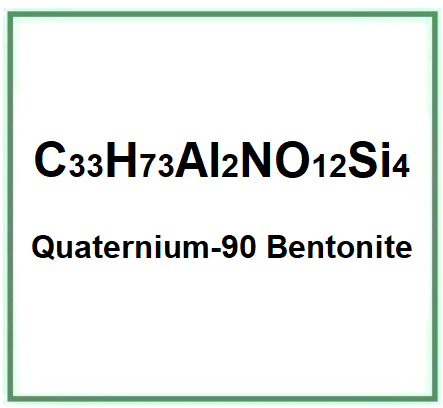Quaternium-90 Bentonite is a chemical compound produced by the reaction of Bentonite and Quaternium-90.
The name describes the structure of the molecule
- "Quaternium-90". This is a generic term used to describe quaternary ammonium compounds. These compounds are often used in cosmetic and hair care products for their conditioning and antistatic properties.
- "Bentonite" is a type of natural absorbent aluminum clay philosilicate that has the ability to swell when it comes into contact with water. It's often used in cosmetics and skincare products for its absorbent and purifying properties.
Description of raw materials used in production
- Bentonite - A natural absorbent aluminum clay philosilicate primarily composed of smectite group minerals.
- Quaternizing Agents - Compounds used to introduce quaternary (positively charged) groups into the bentonite.
Step-by-step summary of industrial chemical synthesis process
- Preparation - Bentonite is purified and dried.
- Quaternization - Quaternizing agents are added to the bentonite. This process introduces positively charged groups to the bentonite, making it dispersible in water and other solvents.
- Purification - Any impurities or excess quaternizing agents are removed.
It appears in the form of a white powder.

What it is for and where
Cosmetics
Viscosity control agent. It controls and adapts, Increasing or decreasing, viscosity to the required level for optimal chemical and physical stability of the product and dosage in gels, suspensions, emulsions, solutions.
Safety
It is to consider the risk of cumulative aluminum intake, which may pose a danger to human health, cannot be ruled out even if it is a cosmetic product that is only smeared on the skin and not ingested (1).
References_________________________________________________________________________
(1) Wong, W.W., Chung, S.W., Kwong, K.P., Yin Ho, Y. and Xiao, Y., 2010. Dietary exposure to aluminium of the Hong Kong population. Food Additives and Contaminants, 27(4), pp.457-463.
Bratakos, S.M., Lazou, A.E., Bratakos, M.S. and Lazos, E.S., 2012. Aluminium in food and daily dietary intake estimate in Greece. Food Additives and Contaminants: Part B, 5(1), pp.33-44.
![]() Quaternium-90 Bentonite
Quaternium-90 Bentonite 

